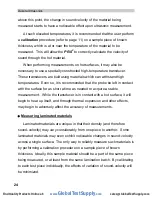
PR-8
2
Sonic Tester
13
At this point, the
PR-8
2
has successfully calculated it's internal error
factor, and will compensate for this value in any subsequent
measurements. When performing a "probe-zero", the
PR-8
2
will always
use the sound-velocity value of the built-in probe-disc, even if some other
velocity value has been entered for making actual measurements. Though
the
PR-8
2
will remember the last "probe-zero" performed, it is generally a
good idea to perform a "probe-zero" whenever the tool is turned on, as well
as any time a different transducer is used. This will ensure that the
instrument is always correctly zeroed.
Calibration
In order for the
PR-8
2
to make accurate measurements, it must be set
to the correct sound-velocity for the material being measured. Different
types of material have different inherent sound-velocities. For example, the
velocity of sound through steel is about 0.233 inches-per-microsecond,
versus that of aluminum, which is about 0.248 inches-per-microsecond. If
the tool is not set to the correct sound-velocity, all of the measurements the
tool makes will be erroneous by some fixed percentage. The
one point
calibration is the simplest and most commonly used calibration procedure -
optimizing linearity over large ranges. The
two point
calibration allows for
greater accuracy over small ranges by calculating the probe zero and
velocity. The
PR-8
2
provides three simple methods for setting the sound-
velocity, described in the following pages.
www.
GlobalTestSupply
.com
Find Quality Products Online at:














































